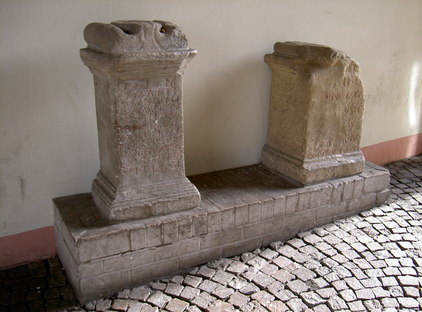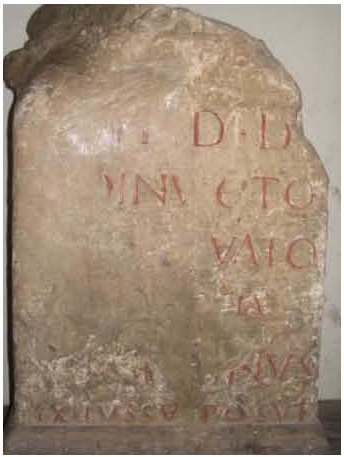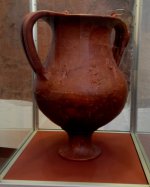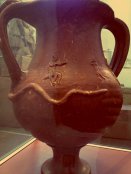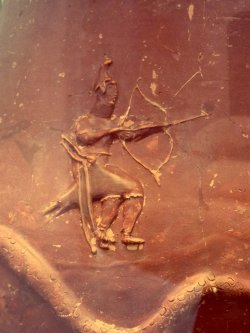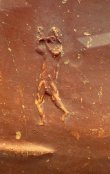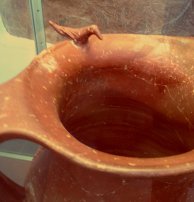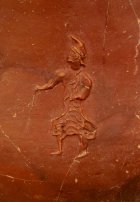
CIMRM Supplement - Mithraeum. Ballplatz, Mainz, Germany.
CIMRM lists a couple of items from Mainz.
But in August 1976 building work in the Ballplatz square in Mainz (Roman Mogontiacum) uncovered a Mithraeum. This was outside the Roman legionary fortress.1 Unfortunately the site was destroyed without being recorded, and items from it were looted. In 2008 the materials from it were published by I. Huld-Zetsche.2 These notes are from material online.
According to the German Wikipedia article on Mogontiacum, the pottery finds dated the construction to 70-80 AD, which would make it the first such known. The overall length was 30m.3 The early date might be supported by the discovery of a temple of the Magna Mater, and also of Isis, in 1999, which was scientifically excavated and dated to the reign of Vespasian, earlier than the cult of Isis was previously known in this area. The massive deployment of troops from all over the empire is perhaps responsible.4
The finds that survived include two inscribed altars, a remarkable pottery krater with Mithraic figures, a fragment of another krater with an inscription, and an inkwell. The two altars are on a base in a covered passage on the west side of the Ballplatz.
Coordinates: 49° 59' 56" N, 8° 16' 16" E / 49.9945° N, 8.2672° E.5
Some quotations
From Eric Rebillard, Jorg Rupke, Group Identity and Religious Individuality in Late Antiquity, CUA, 2015, p.231:
The mithraeum in Praesenzgasse/Ballhausplatz im Mainz, which was destroyed in the course of construction work on site, belongs to the class of spectacular finds that were, unfortunately, never properly documented. Rectangular in form, it was roughly twenty-two meters long, with a three-meter-wide aisle running down the middle.42 Including the arc, measurements of which can no longer be estimated, the sanctuary would have measured some thirty meters in length, making it one of the largest sites of the Mithras cult in the Roman world.43 Findings include two Mithras altars dating to Severan times (nos. 17 and 18), two large, double-handled vessels, one of them the notable "Schlangenkrater," numerous incense chalices and clay lamps—all in all about six hundred smaller finds.44 Moreover, two altar bases are said to have been found in situ,45 The earliest ceramics date to the years of Vespasian’s reign, and the mithraeum must therefore have been in use no later than the last third of the first century A.D., making it also one of the oldest north of the alps. It underwent some changes until it was abandoned in the fourth century A.D. 44.One of the most important finds is the fifty-five-centimeter-tall "Schlangenkrater," with an inscription noting Quintus Ca ... as the dedicant for Mithras Invictus (no. 16) and showing in some detail seven members of the Mithras cult being grouped in the spaces between the handles in groups of three and four. The krater is dated to between 120 and 150 A.D.47 It was found in situ un-
From Ezquerra, p.358:
The length of the cella of the ‘Ballplatz* mithraeum in Mainz, destroyed without excavation in 1976, has also been estimated at c. 30m long, though this is frankly a guess.606606 I. Huld-Zetsche, "Ein Mithraeum in Mainz". Archaologie in Rheinland-Pfalz 2002 (Mainz 2003) 75-8.
And Ezquerra, p.347-8:
The now well-known Schlangengefass from the never-excavated mithraeum beneath the Ballplatz in Mainz is a slightly different matter. One face depicts in barbotine technique what seems to be a procession, moving to the left (Text-fig. 4).370 First comes a small figure wearing a cuirass, evidently a Miles, then, on a larger scale, a Pater, striding along in a stately manner, with a staff or walking stick. He is followed by an equally large figure wearing a solar crown and brandishing a whip, evidently a Heliodromus. Both of these figures wear beards. The last figure, the same size as two preceding ones (i.e. larger than the Miles), is a young man carrying a walking stick erect in the air.Earlier interpretations saw these four figures, together with the three on the other face, as representations of the seven grades, i.e. as strictly parallel to the sequence on the east wall at S. Prisca. In order to do this, however, there had to be a good deal of tucking and pulling: since there is clearly a Pater on the other face, the figure I see as Pater had to become a Perses.ilx Beck however has ingeniously identified the group as a ‘Procession of the Sun-Runner5, a mimesis of the sun’s annual journey through the heavens, as a validation of the mithraeum’s function as an image of the universe and as a representation of the destiny of souls.572 More recently, he has suggested that it might be an equinoctial ritual celebrated on the two appropriate days of the year: ...
A mysterious document, "The Development of the Cult of Mithras in the Western Roman Empire" on Scribd here:
... has published a fine bone ink-well from the Ballplatz Mithraeum in Mainz, rightly remarking that it shows that it was necessary in the cult’s day-to-day life to write documents which could not conveniently be kept on wax tablets -–precisely, one may think, lists of grade acquisition and membership, as well as financial records and, no doubt, liturgical texts of the kind we possess in scraps from Sta Prisca and Dura-Europos.
Altar to Mithras and Mars, dedicated by Secundinius Amantius
The first altar is marble, and dates to 151 AD – 230 AD. It is 91 cm high, 47.5 cm (Br.), 36 cm (deep). The lettering is 3.8-2.5 cm high.6 AE 1979, 425.
D(eo) I(nvicto) M(ithrae)/ et Marti/ Secundini/us Amantius/ cornicu(larius)/ praef(ecti) leg(ionis)/ XXII permi/ttente Pri/mulo patre/ ex voto pos/uit l(ibens) l(aetus) m(erito)
"To the Unconquered Sun God Mithras and Mars. Secundinius Amantius, cornicularius [=supply officer] to the prefect of the 22nd Legion, with the permission of Primulus the Pater, dedicates this willingly in fulfilment of a vow.
Altar of M. Satrius Saturninus
Broken sandstone altar, currently (77) cm H, 50cm W, 45cm D, letter size 4.7-3.2 cm. 151 AD – 230 AD.
[ ] H D D [ ]O INVICTO [ ]VATO [ ]RIVS SATVR[ ]INVS EX IVSSV POSVIT[In] h(onorem) d(omus) d(ivinae) / [De]o Invicto / [Conser]vato/[ri M(arcus)? Sat?]rius / Satur[n]inus / ex iussu posuit
"In honour of the temple, to the unconquered god, the Conservator, Marcus Satrius Saturninus did this by order."
Inscribed pottery fragment.
AE 2004, 1027. AE 2008, 0968.
Dated AD 120-150, this fragment of a krater contains the following inscription:
[ ]NV[ ]T M[ ] D [ ] QVINTVS CA[ ][Deo I]nv[ic]t(o) M[ithrae d(onum)?] d(edit) [l(ibens) l(aetus) m(erito)] Quintus Ca[---]
"To the unconquered god Mithras, Quintus Ca--- gives this gift freely."
Crater with figures
This vessel is approximately 40 cm high, 27 cm in diameter (upper rim) and dated to between 120-150 AD.
From here:7
... Mithras shoots an arrow at a rock-face, from which water then gushes. 65 In this scene, Mithras is very often accompanied by two youths (occasionally by only one) wearing Phrygian caps, sometimes represented in a supplicatory gesture, or catching the water gathered in their cupped hands.66 Their identity as Cautes and Cautopates is guaranteed by one of the lines of verse from Santa Prisca.67 Until recently, there has been no indication that this particular scene played any role in Mithraic ritual. This situation was, however, dramatically changed by the discovery of a crater (a wine mixing bowl) buried under one of the floor-levels of the mithraeum in the centre of Mainz (ancient Mogontiacum, a major administrative centre of the Roman province Germania Superior).68 This cult vessel69 carries two scenes of ritual created in the expensive and difficult barbotine technique.70 One, named by Roger Beck the “Procession of Heliodromus”, can be disregarded here since it has no obvious parallel in Mithraic iconography or Mithraic myth.71 The other, however, named by Beck the “Archery of the Father”, seems to be particularly relevant to our argument. It portrays three participants in the course of a ritual. The first person, a man with full beard and a Phrygian cap sitting on a folding chair, is aiming an arrow, set to the string of a bow, at another man in front of him. This man, the initiand, is portrayed as proportionally smaller, beardless and naked; he raises his hands, which are apparently tied at the wrist, in terror to protect his face.72 Behind the naked man we can see a third person also with full beard and dressed in a tunic. In his left hand, he holds an unidentifiable object. His right hand is raised in a gesture which signals, according to the rules of ancient rhetoric, communication of important information. 73 The general identification of roles of the individual participants of this ritual is unproblematic. The sitting man with a bow is, due to his dignified appearance and the Phrygian cap he wears, to be identified as the Mithraic Father.74 The man on the right plays the role of a mystagogos pronouncing the legomena necessary to successful completion of initiation. 75 This scene plays a crucial role in our argumentation since it provides support for the hypothesis that the mythical episode of Mithras’ archery was also adapted – at least in this specific community in Mogontiacum – as a model for a ritual actually performed by local Mithraists during their cultic gatherings.76
External links
- Epigraphische Datenbank Heidelberg HD008176. The altar to Mithras and Mars. More photos F012793 F014440 F016215
- Epigraphische Datenbank Heidelberg HD008179. Second altar.
- Epigraphische Datenbank Heidelberg HD052182 - inscribed pottery fragment.
- Wikimedia commons image of the Mithras and Mars altar here.
- Arachne Main altar. Including lots of pictures. Dates discovery to August.
- Ubi Erat Lupa Main altar
- Ubi Erat Lupa Second altar showing reconstruction.
- Csaba Szabó Mithraic vessel from Ballplatz, 2015: "The importance of the find lies in the reliefs of the vessel, representing seven figures, symbols of the initiation grades. The figures are presented in a very delicate, expressive way, showing certain movements or even sequences from the initiation ritual. Although many of the figures and scenes are represented on reliefs, the Ballplatz vessel is unique, because it represents also movements and an outstanding lived religious experience of the worshipers."
| 1 | German Wikipedia article on Mogontiacum. Retrieved 9/8/16. |
| 2 | Ingeborg, Huld-Zetsche, Der Mithraskult in Mainz und Das Mithräum am Ballplatz, Mainz: Generaldirektion Kulturelles Erbe, Direktion Archäologie, 2008. 245 p. Series: Mainzer archäologische Schriften Bd. 7. ISBN 9783935970051. I have not seen this publication. |
| 3 | The reference given for these claims is Wolfgang Spickermann, "Mogontiacum (Mainz) als politischer und religiöser Zentralort der Germania superior". In: Hubert Cancik, Alfred Schäfer, Wolfgang Spickermann (Hrsg.), Zentralität und Religion. Mohr Siebeck, Tübingen 2006, ISBN 3-1614-9155-6 (Studien und Texte zu Antike und Christentum, vol. 39). The page numbers are p.184 f, and p.186. However I have not seen this myself, and it would be wise to treat any claim from Wikipedia with great circumspection. "Eine genauere Lokalisierung ist bei anderen Heiligtümern und Kultstätten möglich. Bereits 1976 wurde am Ballplatz und damit am Fuß des Kästrichs mit seinem Legionslager ein Mithräum ergraben, das allerdings im Zuge weiterer Bauarbeiten zerstört wurde.[81][82] Ungewöhnlich ist hier die sehr frühe Verehrung des Mithras, die durch Keramikfunde in den Zeitraum zwischen 70 und 80 und somit in flavische Zeit datiert werden konnte. Mit einer Gesamtlänge von 30 m ist es das älteste und größte bislang nachgewiesene Mithräum des römischen Imperiums. Entstehungszeit, Größe und Ausstattung lassen auf ein großes Ansehen des Heiligtums und dessen große Rolle bei der Verbreitung des Kultes in den beiden germanischen Provinzen schließen.[83]" i.e. "A more accurate localization is possible with other shrines and places of worship. As early as 1976 in the Ballplatz, and thus at the foot of the castrum and legion camp, a Mithraeum was excavated, which was destroyed in the course of further construction. [81] [82] This very early worship of Mithras is unusual, which, from pottery finds in the period 70 and 80, could thus be dated to the Flavian period. With a total length of 30 m, it is the oldest and largest so far proven Mithraeum the Roman Empire. The date of construction, the size and the features suggest the importance of the sanctuary and its major role in the spread of the cult in the two Germanic provinces.[83]" |
| 4 | German Wikipedia article on Mogontiacum once more, again based on Spickermann. |
| 5 | Supplied by a reader but not checked. |
| 6 | Epigraphische Datenbank Heidelberg HD008176. |
| 7 | Aleš Chalupa – Tomáš Glomb, "The Third Symbol of the Miles Grade on the Floor Mosaic of the Felicissimus Mithraeum in Ostia: A New Interpretation", In: Religio 21 (2013), 9-32; 25-27. Online here. |
| Tweet |

